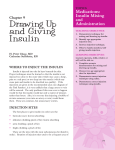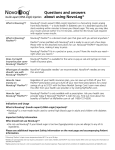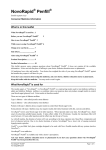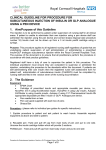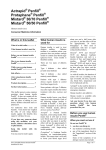Download Traveling and Diabetes - American Academy of Family Physicians
Transcript
Traveling and Diabetes Tips for a trouble-free journey Managing diabetes while traveling Travel is an important and enjoyable part of life for most people. Business trips, visits to friends or relatives, and vacations are all “can do” activities for people with diabetes. The key to successful traveling is careful planning to make your trip as safe and stress-free as possible. This booklet will tell you about: • Things to do before you take a trip • Diabetes-related items to carry with you • Precautions to keep in mind while traveling • The American Academy of Family Physicians Foundation has favorably reviewed this material through 2007. Favorable review means that medical information is accurate, but does not imply endorsement of any conclusions presented. How to manage eating and exercising away from home, and • Other reminders for safe, stress-free travel The Keeping Well With Diabetes patient education materials were developed using information from the following sources: The American Association of Diabetes Educators, The American Diabetes Association, The American Dietetic Association, and The American Association of Clinical Endocrinologists. These booklets do not replace the advice of your healthcare provider. Be sure to consult your healthcare provider regarding your individual diabetes treatment plan. 1 Before your trip Visit your healthcare provider for a checkup before traveling and discuss your travel plans. You may need to adjust your treatment or monitoring plan. Ask for extra prescriptions in case you need to buy diabetes medicine or supplies during your trip. Also ask for prescriptions for medicines for motion sickness and traveler’s diarrhea, just in case. It may also be helpful to have contact information for a healthcare professional at your destination. What to pack In addition to your main suitcase, pack a small tote bag or backpack to keep your diabetes medicine with you during your trip. Stock it with all the supplies you will need to manage your diabetes while traveling. To be safe, include twice the amount of diabetes medicine and blood glucose monitoring supplies you think you will need. You never know when a trip will be delayed or canceled. Items to pack to ensure a trouble-free journey include: • Insulin delivery system (pen or syringe) and needles • Snacks and extra food for long trips • Blood glucose meter, strips, batteries, and user manual • Extra insulin pump batteries and supplies (if you use one) Also pack urine ketone strips, alcohol and cotton balls, comfortable shoes and socks, emery boards, and sunblock. 2 3 Travel Tips Traveling with insulin If you are traveling by plane, find out if your airline has any special rules for passengers who need to carry insulin syringes and supplies on flights. Let airport security people know that you have diabetes and are carrying your supplies with you. Make sure your insulin vials and supplies are in their original packaging with their original prescription labels. Keep lancets capped, and be sure your glucose meter has the maker’s name on it. If you wear an insulin pump, ask airport security personnel to inspect it without removing it from your body. Ask for the security checkpoint supervisor if you have any problems. Never leave insulin in a parked car or car trunk or any other place where it may get too hot or too cold. When traveling, keep insulin in a cool, dry place. Talk with your healthcare provider about whether an insulin delivery system or combined blood InDuo insulin delivery system glucose monitoring and insulin dosing system might be right for you. To find out more, visit our website at www.insulindevice.com. 4 ® 5 Carry Identification Eating right while traveling Before you leave on your trip, be sure you are wearing your medical ID bracelet or necklace stating that you have diabetes and listing your name, address, and an emergency phone number. Also, carry a card in your wallet or purse with this information. The card should also list your healthcare provider’s name and phone number, the medicines you take, and the dosages. If you are traveling with other people, tell at least one of them you have diabetes and what to do in an emergency. Also, let those you are visiting know you have diabetes so they can adapt their plans, if necessary, to your needs for medicine, food, and exercise. If you are traveling alone by plane, tell the flight attendant that you have diabetes. Always carry snacks when traveling. Cheese, crackers, and fruit are good choices. Carry glucose tablets or other carbohydrate-rich foods also, in case of a low blood glucose (hypoglycemia) problem. If you feel symptoms of hypoglycemia, test your blood glucose right away. Eat something sweet and wait 10 or 15 minutes before retesting or continuing your travels. Meals and snacks are now limited on many airline flights. Call the airline at least 24 hours before your flight and ask about the food being served. Many airlines offer special meals that may fit your meal plan. Don’t give yourself a pre-meal injection until you are sure your food is about to be served. Food service may be delayed or canceled. 6 7 Keep moving Leaving the country To promote good blood circulation, health experts recommend you don’t cross your legs while sitting. When traveling by plane, try to walk up and down the aisle a few times during the flight. Also, drink lots of water during trips. Driving in hot weather and long airline flights can cause you to lose body fluids (dehydration). If you must stay seated, you can still exercise. Lift each knee and rotate your ankles several times during your trip. When traveling by car, stop at least every 2 hours and walk around to stretch your legs. When traveling by bus or train, get up from your seat every hour or so and stretch or walk. See your healthcare provider for a checkup before your trip. You may need certain immunizations before visiting some countries. Ask your healthcare provider or airline if there are any “health alerts” for the countries you will visit. Also, carry your insurance card and check if your health plan will cover you while you are out of the country. Before buying insulin or syringes in another country, talk to a doctor or pharmacist. The strength of insulin and syringe sizes may be different. You should also carry extra prescriptions listing both brand and generic names of the medicine you take. A list of sentences such as “I have diabetes” and “Please get me a doctor” written in the languages of the countries you visit may be helpful. 8 9 Crossing time zones Watch what you eat If you take insulin and you travel across time zones during your trip, your medication schedule may need to be adjusted. Traveling west to east, you lose time and may need to skip a dose of insulin. Traveling east to west, you gain time and may need an extra dose. Time changes of 3 hours or less may not affect your insulin needs. Changes in your meal plan may also be necessary. Your healthcare provider can help you adjust your diabetes treatment plan to travel-related changes and time zone changes. To avoid being confused by time zone changes, keep your watch set at your home time until you arrive at your destination. Then reset your watch and follow the local time. If you want to eat unfamiliar foods, ask about the ingredients before you order. In countries where traveler’s diarrhea is common, avoid eating fresh fruit, leafy vegetables, milk products, tap water, and ice cubes. Diarrhea, like motion sickness, can upset the balance between your food and insulin needs. Stick with bottled water (drink plenty of it to avoid dehydration) or other bottled drinks. 10 Protect your skin and feet Apply sunblock before you go out during the day. Reapply it often and remember to protect your feet from sunburn and hot sand. Always wear comfortable shoes and socks that fit well. Check your feet daily for signs of blisters or other injuries, especially if you are doing a lot of walking. 11 After your arrival When you get to your destination, there are a number of things you can do to ensure a safe and enjoyable stay. Traveling almost always requires changes in your usual routine, so you might want to check your blood glucose level more often. Plan how and when you will get the exercise you need each day. A brisk walk for 20 or 30 minutes is almost always possible, no matter where you travel. When making reservations, ask your hotel if they have a fitness center, swimming pool, or other exercise facilities. Another option is to pack some exercise equipment in your suitcase, such as resistance bands or light weights, so you can exercise in your room. Pack your bags, follow these tips and “Have a Great Trip!” 12 Keeping Well With Diabetes We’re pleased to offer you this booklet as part of the Keeping Well With Diabetes patient education program. But Keeping Well With Diabetes can bring you so much more. When you become a member of Keeping Well With Diabetes, a FREE program just for people who take insulin, you'll receive tools and materials that can make a difference in your daily life. Simply complete and return the postage-paid card in this booklet, call 1-800-474-KWWD (1-800-474-5993), or visit our website at www.kwwd.com. At Keeping Well With Diabetes Online, you’ll find useful information on living with diabetes, online newsletters, and ® NovoTrack, a unique site that provides you with your own Personal Scorecard to keep track of your diabetes management. Novo Nordisk has been a world leader in diabetes care and treatment for more than 80 years. We do all we can—every single day—to continue to bring you new products and new services designed to help you keep well with diabetes. For additional information on Novo Nordisk products designed to make living with diabetes easier, or to become a member of Keeping Well With Diabetes, a free program just for insulin users, call us at 1-800-727-6500. Visit us online at www.novonordisk-us.com. Any change in insulin should be made cautiously and only under medical supervision. Novo Nordisk is a worldwide leader in diabetes care. NovoPen, Novolin, PenFill, InnoLet, Innovo and NovoTrack are registered trademarks of Novo Nordisk A/S. InDuo is a trademark of LifeScan, Inc., a Johnson & Johnson company. www.novonordisk-us.com The photographs used in this booklet are for illustration only. The models in the photographs do not necessarily have diabetes or other ailments or use or endorse any products mentioned. Copyright © 2003 Novo Nordisk Pharmaceuticals, Inc. 4/2004 125994 Printed in the U.S.A.











